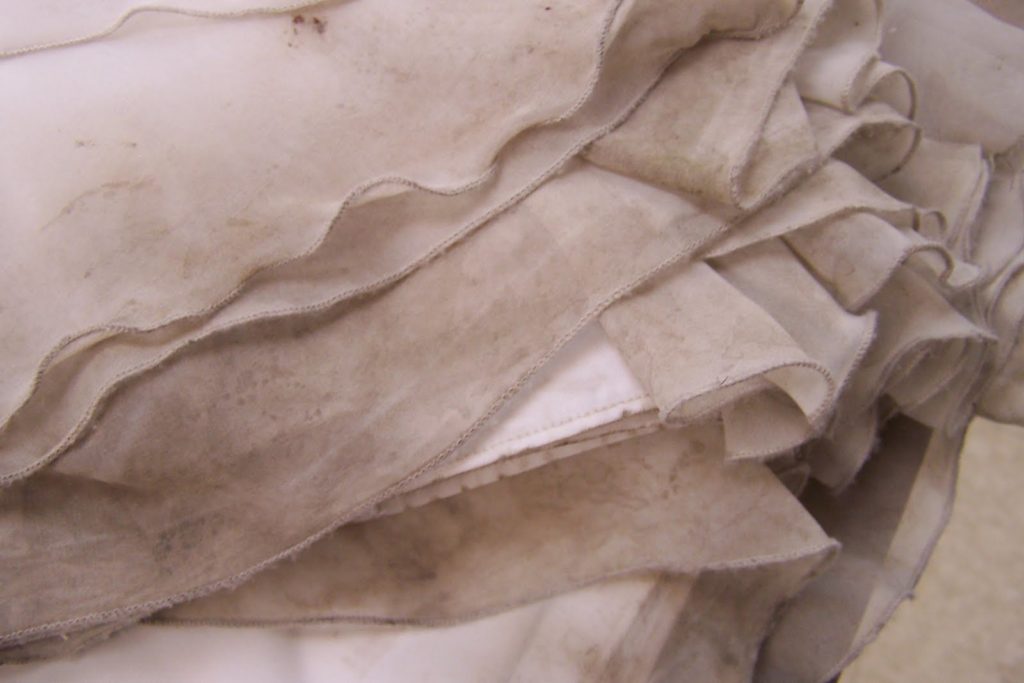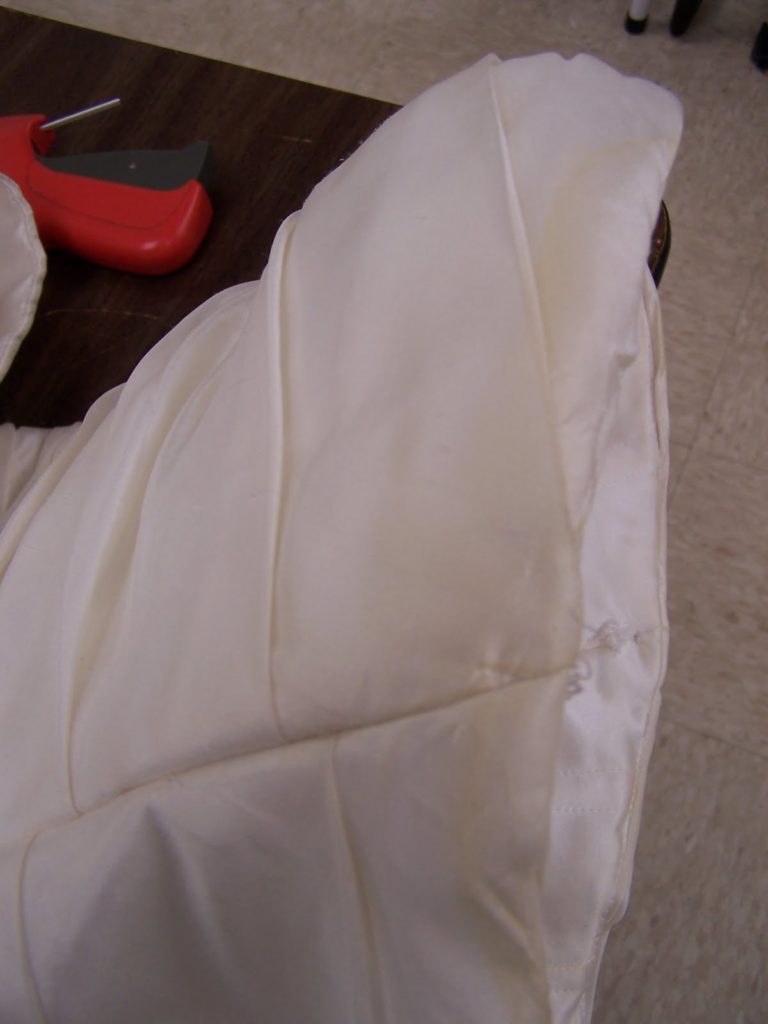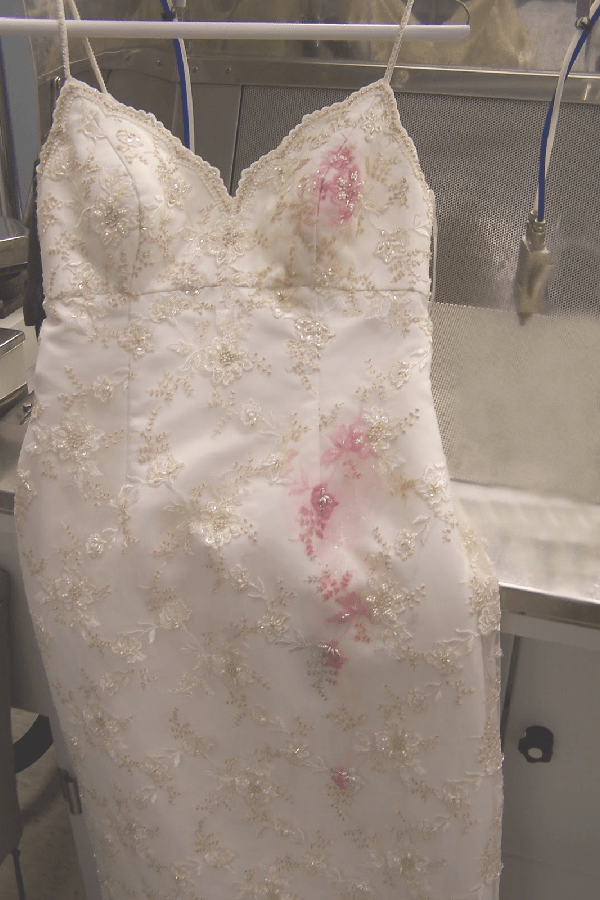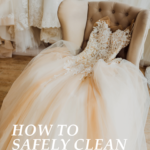With wedding season in full swing its time to prepare your cleaning team for some of the unique challenges that bridal gowns bring to the cleaning department. Some dresses can seem like a mission impossible, but with a basic understanding of fibers and fabrics, stain identification, and some patience a majority of gowns can be cleaned with excellent results.
Let’s start with some basic rules to gown cleaning:
1. A comprehensive inspection of the outside and all of the layers of the gown is essential. Take your time and mark with tape all stained and soiled areas. Make notes of all damage before proceeding.
2. The goal is to safely and effectively clean the gown as best as possible without causing damage.
3. We want to work to minimize risk to the gown and any embellishments by cleaning in the wash wheel the fewest times possible.
4. The gown construction along with the severity and types of stains will dictate the cleaning process we choose. The tips set forth will be broken down into three potential cleaning methods. It is up to you to decide which method will best suit your situation.
Wet cleaning (WC): The ability to safely and effectively clean dry-clean only gowns in water.
Spotters:
• DEPRIT Professional 1-6
• LANADOL AVANT – For heavy hemline soil
• LANADOL AVANT mixed 50/50 with water
For general soiling and stains wash formulas:
LANADOL Sensitive (AKTIV & APRET) – For all silk, acetate and rayon gowns
LANADOL Dry (XPRESS & APRET)– For all polyester gowns
Drycleaning in SOLVONK4 (K4):
For SYSTEMK4 operators only which will allow the unique cleaning power of SOLVONK4 to be used on all gown types. Testing of beads and crystals with pure cleaning solvent is necessary.
Spotters:
• DEPRIT Professional 1-6
• PRENETT K4 – For heavy hemline soil
- PRENETT K4 Mixed five parts PRENETT K4- 5 five parts SOLVONK4 two parts water – For hemline soil and general stains
Wash Formula: two bath program for light garments
Drycleaning in Perc, Hydrocarbon or D5 Siloxane (P/HC/D5): Solvents with limited usage of moisture. Testing of beads and crystals with pure cleaning solvent is necessary.
Spotters:
- DEPRIT Professional 1-6
- PRENETT CS – For heavy hemline soil & leveling
- PRENETT CS – Mix two parts PRENETT CS – one part water – For hemline soil and general stains
Wash Formula: two bath program for light garments
Inspection:
When inspecting a gown, please be sure to note all stains, damages, discolorations, pulls, snags, loose beads, worn areas, everything. Bridal clients are the most scrupulous of all clients we deal with, and the inherent value, as well as sentimental value, is very high. Be as detailed as possible and be sure to point out every discrepancy to the client while they are in front of you. It is critical that all severe damages are noted on the invoice and adequately communicated to the client before you proceed. Take pictures whenever possible.
Sorting (Triage)
The sorting process is one of the most critical decision points in the production process. Proper sorting and classification will allow for the most efficient use of time, allow for the best possible outcome, and reduce the risk of damage in the process. All gowns should be sorted according to how they will be cleaned and handled.
The First Sort:
Drycleaning? – Wetcleaning?
- Nylon, Polyester & Cotton gowns or gowns with large wine, champagne, beer, beverage, grass or beach type staining should be sorted out for the wet-cleaning department.
- The remainder of the gowns consisting of acetates, rayons, and silks, velvet and blends should be set aside for dry-cleaning.
Drycleaning Sort
Dry-cleaning gowns should then be sorted according to the soil level. After each cleaning, an assessment of the dress should be taken, and it should then be sorted into the next appropriate classification. Some gowns may take multiple cleaning to get to the desired result.
Very Heavy Soil – Using a dry brush and the air gun lightly brush or blow as much mud, dirt or sand off of the gown. These gowns should be run through a single bath cleaning formula to remove the heavy soil before spotting. Once this is completed, proceed to the following steps for stain removal and cleaning protocol.
Drycleaning in SYSTEMK4 –
- Be sure to test all beads and crystals with pure solvent. Use a dry brush and air to remove all loose soil.
- Follow the DEPRIT Professional 1-6 Chart to remove all stains.
- Use the steam gun to moisten all soiled areas of the hemline.
- Apply PRENETTK4 directly on the black line on the fold of the hemline using the bone or brush to loosen the soil as you rotate around the entire bottom.
- Apply The PRENETTK4 mixture on the remaining soil of the hemlines and other locations on the gown.
- Work extremely soiled areas further with a steam gun and PRENETTK4 to until soil is removed or loosened.
- Hang garment for 15-20 minutes to allow the spotting solutions to work. In the event, the areas get dry reapply PRENETTK4 mixture.
- If the gown is beaded, turn inside out and place loosely in a large net bag.
- Place gowns in the SYSTEMK4 machine and run your standard two bath light program.
Cleaning in P/HC/D5 –
- Be sure to test all beads and crystals with pure solvent.
- Use a dry brush and air to remove all loose soil.
- Follow the DEPRIT Professional 1-6 chart to remove all stains.
- Use the steam gun to lightly moisten all soiled areas of the hemline.
- Apply PRENETT CS directly on the black line on the fold of the hemline using the bone or brush to loosen the soil as you rotate around the entire bottom
- The PRENETT CS mixture on the remaining soil of the hemlines and other locations on the gown.
- Work extremely soiled areas further with a steam gun and PRENETT CS to until soil is removed or loosened.
- Hang garment for 40-60 minutes to allow the spotting solutions to work and until they spotted area is only slightly damp.
- If the gown is beaded turn inside out and place in a large net bag.
- Place gowns in the dry cleaning machine and run your standard two bath light program.
When deciding whether to Wetclean or Dry clean the decision to sort towards Wetcleaning should be based on the types and severity of the stains.
For example, a silk wedding gown with large wines stains all over it would be best serviced in the LANADOL Sensitive program then in a dry cleaning system. A polyester gown with general soiling would be best serviced in the LANADOL Dry program to get maximum cleaning power for such a durable fiber.
Here are some examples:
Large water or beverage staining
Severe wine stains
Stain Removal for Wetcleaning –
- Use a dry brush and air to remove all loose soil.
- Follow the DEPRIT Professional 1-6 Chart to remove all stains.
- Use the Steam gun to moisten all soiled areas of the hemline.
- Apply LANADOL AVANT directly on the black line on the fold of the hemline using the bone or brush to loosen the soil as you rotate around the entire bottom.
- Apply The LANADOL AVANT mixture on the remaining soil of the hemlines and other locations on the gown.
- Work extremely soiled areas further with steam gun and LANADOL AVANT to until soil is removed or loosened.
- Hang garment for 10-15 minutes to allow the spotting solutions to work. If the gown dries simply remoisten with the steam gun.
- If gown is beaded turn inside out and place in a large net bag.
- Place gowns in the Wetcleaning machine and select the appropriate program as defined below:
- LANADOL Sensitive (AKTIV & APRET) – For all silk, acetate and rayon gowns
- LANADOL Dry (XPRESS & APRET)– For all polyester gowns
- Follow the normal drying steps based on the wash program you selected
- LANADOL Sensitive – Dry to 15% residual Moisture or 3-5 minutes on medium heat (140 F)
- LANADOL Dry – Dry to 85% residual moisture or 5-10 minutes on medium dry 140F
By using these basic guidelines, you will find that you will be very successful at cleaning with a high degree of quality for a majority of the wedding gowns you will receive. Remember there are always exceptions to these guidelines so refer back to the ground rules at the beginning of this article.
When in doubt, contact your Kreussler Technician who is skilled in all of these procedures and can assist you with dealing with all of the unique challenges you be faced with.








